Are you craving a mouthwatering combination of sweetness and savory flavors that will transport your taste buds to a world of culinary delight? Look no further than the delectable Sooji Halwa Puri! This iconic dish is a beloved part of Indian cuisine, known for its perfect balance of semolina-based halwa and crispy puris. In this article, we’ll take you on a flavorful journey, from the history of this delightful dish to a step-by-step guide on how to create it in your own kitchen. Get ready to tantalize your senses and impress your family and friends with your culinary skills.
[ez-toc]
History
As you savor the delightful combination of Sooji Halwa Puri, it’s worth taking a moment to travel back in time and explore the fascinating history that has led to the creation of this iconic dish. This sweet and savory symphony has a tale to tell, one that spans generations and cultures.
Roots in Culinary Heritage
The origins of Sooji Halwa Puri can be traced back to the heart of Indian cuisine, where it has evolved as a cherished part of culinary heritage. Rooted in tradition, this dish has been passed down through generations, a testament to the way food has been a central aspect of Indian culture.
A Glimpse into Tradition
In India, food is more than sustenance; it’s a means of connecting with one’s roots and celebrating life’s moments. Sooji Halwa Puri embodies this sentiment perfectly. Often prepared during festivals, weddings, and other special occasions, the dish carries with it a sense of joy, togetherness, and celebration.
Influences and Adaptations
While the core elements of Sooji Halwa Puri have remained consistent, regional variations and adaptations have given rise to a diverse range of flavors. Different regions of India have put their own spin on the dish, incorporating local ingredients and techniques. This culinary diversity is a testament to the rich tapestry of Indian cuisine.
Symbolism and Significance
Beyond its delicious taste, Sooji Halwa Puri holds symbolic significance. The combination of sweet halwa and savory puris is a reflection of the balance that life itself requires. It’s a reminder that life is a blend of ups and downs, and that savoring both the sweet and the savory moments is essential.
A Staple in Festive Feasts
Sooji Halwa Puri has earned its place as a staple in festive feasts across India. During Diwali, the Festival of Lights, it graces dining tables as families gather to celebrate the victory of light over darkness. Similarly, during weddings, Sooji Halwa Puri is often served as a symbol of abundance and good fortune.
Modern Times and Culinary Revival
In recent times, as traditional recipes make a comeback, Sooji Halwa Puri has found itself in the spotlight again. Chefs and home cooks alike are embracing the beauty of simplicity and the nostalgic charm of this dish. Its presence on social media platforms and cooking shows has rekindled interest, introducing it to a new generation of food enthusiasts.
Preserving Tradition, One Bite at a Time
As we indulge in the delightful flavors of Sooji Halwa Puri, we pay homage to the countless hands that have lovingly prepared this dish over the years. Each bite carries with it the essence of history, culture, and tradition. Sooji Halwa Puri is more than a recipe; it’s a connection to the past, a celebration of the present, and a legacy to be passed on to the future.
In every plate of Sooji Halwa Puri, there lies a tale of generations united by a shared love for food, family, and festivity. As you savor this time-honored combination, take a moment to reflect on the journey it has undertaken, and the stories it continues to tell with each delicious bite.
Time
| Step | Time |
|---|---|
| Preparing the Sooji Halwa | 15 minutes |
| Making the Fluffy Puris | 30 minutes |
| Total Preparation and Cooking Time | 45 minutes |
Please note that these times are approximate and can vary based on individual cooking skills and kitchen setup.
Ingredients
| Ingredients for Sooji Halwa | Ingredients for Puris |
|---|---|
| 1/2 cup fine sooji (semolina) | 1 cup whole wheat flour |
| 2 tablespoons ghee | Water (as needed) |
| 1/4 cup sugar | 1/4 teaspoon salt |
| 1 cup water | Oil (for frying) |
| 1/2 teaspoon crushed cardamom | |
| Chopped nuts (almonds, cashews) |
This list covers the essentials for a satisfying 2-person serving of the delectable Sooji Halwa Puri. Remember, you can adjust the quantities based on your preference and appetite.
Directions
Step 1: Preparing the Sooji Halwa
Ingredients:
- 1/2 cup fine sooji (semolina)
- 2 tablespoons ghee
- 1/4 cup sugar
- 1 cup water
- 1/2 teaspoon crushed cardamom
- Chopped nuts (almonds, cashews)
- Heat Ghee: In a pan, heat 2 tablespoons of ghee over medium heat until it melts and becomes fragrant.
- Roast the Sooji: Add 1/2 cup of fine sooji (semolina) to the melted ghee. Roast the sooji, stirring constantly, until it turns a golden color and releases a delightful aroma. This should take about 5-7 minutes.
- Boil Water: While roasting the sooji, boil 1 cup of water separately.
- Add Boiling Water: Once the sooji is roasted, carefully add the boiling water to the pan. Be cautious, as the mixture may sizzle.
- Stir and Cook: Keep stirring the mixture continuously to prevent any lumps from forming. The sooji will absorb the water and thicken.
- Sweeten the Deal: Add 1/4 cup of sugar to the mixture and continue stirring. The sugar will dissolve, further enriching the halwa’s flavor.
- A Touch of Aromatics: Sprinkle in 1/2 teaspoon of crushed cardamom for a fragrant twist. This spice adds depth to the halwa’s taste.
- Nuts for Crunch: Toss in a handful of chopped nuts, such as almonds and cashews. These nuts will contribute both texture and a nutty richness.
- Cook to Perfection: Stir the mixture until it reaches a smooth and luxurious consistency. The halwa should no longer stick to the sides of the pan.
Step 2: Making the Fluffy Puris
Ingredients:
- 1 cup whole wheat flour
- Water (as needed)
- 1/4 teaspoon salt
- Oil (for frying)
- Knead the Dough: In a mixing bowl, combine 1 cup of whole wheat flour and 1/4 teaspoon of salt. Gradually add water and knead to form a soft and pliable dough.
- Divide and Conquer: Divide the dough into small, golf ball-sized portions. Roll these portions between your palms to create smooth balls.
- Roll It Out: Take one dough ball and flatten it slightly with your fingers. Dust it with a bit of flour and roll it out into a circular shape using a rolling pin. Aim for a thickness of around 1/8 inch.
- Heat the Oil: In a deep pan, heat oil for frying. The oil should be at a medium-high temperature for the puris to puff up.
- Fry to Perfection: Carefully slide the rolled-out puri into the hot oil. It should start puffing up within a few seconds. Gently press it down with a slotted spoon to help it puff evenly. Fry until the puri turns golden brown, then flip and fry the other side.
- Drain and Repeat: Once the puri is fried to a delightful crispness, use a slotted spoon to remove it from the oil. Allow any excess oil to drain off.
- Repeat the Process: Repeat the rolling and frying process for the remaining dough balls.
Step 3: Bringing It Together
- Serve and Enjoy: Place a generous portion of the aromatic Sooji Halwa on a plate, accompanied by a stack of the freshly fried puris. The contrasting flavors and textures are sure to delight your taste buds.
- Garnish and Present: To enhance the visual appeal, garnish the halwa with slivered almonds and a sprinkle of saffron strands. The vibrant colors will make your dish even more inviting.
- Pair with Sides: Serve your Sooji Halwa Puri with a side of spicy potato curry or tangy chutney. The combination of sweet and savory will create a harmonious culinary experience.
- Savor the Journey: As you enjoy each bite of this iconic duo, take a moment to appreciate the effort and tradition that goes into every plate of Sooji Halwa Puri. It’s not just a meal; it’s a celebration of flavors, cultures, and the joy of sharing food with loved ones.
Now, with these detailed steps, you’re ready to embark on a culinary adventure and create your very own Sooji Halwa Puri masterpiece!
Equipment Required
Nutrition Information
| Nutrition Information | Per Serving |
|---|---|
| Serving Size | 1 plate (approx.) |
| Calories | ~450 calories |
| Total Fat | ~18g |
| Saturated Fat | ~7g |
| Trans Fat | 0g |
| Cholesterol | ~20mg |
| Sodium | ~300mg |
| Total Carbohydrates | ~65g |
| Dietary Fiber | ~3g |
| Sugars | ~25g |
| Protein | ~8g |
Please note that these values are approximate and can vary based on factors such as ingredient brands and specific portion sizes.
Tips
- Golden Roasting: When roasting the sooji for the halwa, aim for a beautiful golden color. This not only enhances the flavor but also gives the halwa its characteristic hue.
- Consistent Stirring: While making the halwa, stir continuously to avoid lumps. A smooth texture is key to a delicious result.
- Warm Water: When adding water to the roasted sooji, use hot or boiling water. This helps prevent lumps from forming and speeds up the cooking process.
- Ghee Goodness: Ghee contributes to the halwa’s rich taste. However, you can adjust the quantity based on your preference for a lighter version.
- Cardamom Crush: Freshly crushed cardamom seeds release a burst of flavor. For extra convenience, you can also use pre-ground cardamom.
- Keep It Crispy: When frying the puris, make sure the oil is at the right temperature. If it’s too hot, the puris might burn, and if it’s not hot enough, they won’t puff up properly.
- Pat Dry: After frying the puris, place them on paper towels to absorb excess oil. This prevents them from becoming overly greasy.
- Customization: Feel free to adjust the sugar quantity to suit your taste. If you prefer it less sweet, you can reduce the sugar amount.
Pros & Cons
| Pros | Cons |
|---|---|
| ✅ Iconic blend of sweet halwa and savory puris | ❌ Moderately high in calories |
| ✅ Rich flavors and aromatic spices | ❌ Requires frying for puris |
| ✅ Cultural and traditional significance | ❌ Contains saturated fats |
| ✅ Versatile—suitable for festive occasions | ❌ Not suitable for gluten-free diets |
| ✅ Balanced mix of textures and tastes | ❌ Can be time-consuming to prepare |
Conclusion
In the delightful marriage of flavors, the Sooji Halwa Puri recipe unveils a culinary symphony that beautifully blends the sweet and the savory, the traditional and the modern. From the warm embrace of the golden-hued Sooji Halwa to the crisp, airy delights of the puris, this dish tells a story of culture, celebration, and the simple joy of savoring a well-crafted meal.
Through every step, from roasting the sooji to the final presentation, this recipe invites you to embrace the artistry of cooking with open arms. It’s not just a recipe; it’s a journey that takes you through time-honored traditions, the heart of Indian cuisine, and the warmth of shared moments.
So, whether you’re planning a special celebration or simply seeking to indulge in a flavorful adventure, the Sooji Halwa Puri recipe promises to be your culinary passport. As you gather the ingredients and embark on this endeavor, remember that the kitchen is your canvas, and each dish you create is a masterpiece in its own right.
So why wait? With a plate of Sooji Halwa Puri before you, you hold more than just food; you hold a piece of tradition, a burst of flavors, and an invitation to explore the magic of cooking. So go ahead, tie on your apron, and let the aromas and tastes of this iconic recipe transport you to a world of culinary delight. Your journey awaits—happy cooking!
Facts
- Fact 1: A Taste of Tradition 🌟
- Did you know that Sooji Halwa Puri isn’t just a dish; it’s a cultural symbol? Passed down through generations, this culinary delight is a piece of Indian heritage that brings families and friends together in celebration.
- Fact 2: Fry-fect Harmony 🔥
- The sizzling sound of puris hitting hot oil isn’t just music to the ears—it’s the sound of magic happening! As the puris puff up and turn golden brown, you’ll feel like a culinary magician orchestrating a spectacular show.
- Fact 3: Spice of Life 🌶️
- Crushed cardamom in the halwa isn’t just a spice; it’s a time traveler! Used in ancient civilizations for its aroma and medicinal properties, cardamom adds a touch of history to your plate of Sooji Halwa Puri.
- Fact 4: Sweet and Savory Dance 🎉
- Imagine Sooji Halwa and Puri as dance partners—sweet halwa swaying elegantly with savory puris. This dish embodies the beauty of contrasts, showing that sometimes, the most harmonious partnerships arise from the most unexpected pairings.
- Fact 5: Festive Fusion 🎊
- Sooji Halwa Puri isn’t just a recipe; it’s a journey through festivals and traditions. During Diwali, the Festival of Lights, this iconic duo graces tables as a beacon of joy and prosperity, illuminating the hearts and taste buds of all who partake.
FAQ’s
Can I use whole wheat flour for the puris?
Yes, you can definitely use whole wheat flour for the puris. It’s a wholesome alternative that adds a nutty flavor and extra fiber to the dish.
What can I substitute for ghee in the halwa?
If you’re looking for a lighter option, you can use clarified butter (also known as “clarified ghee”) or a mild-flavored oil like vegetable oil.
Is Sooji Halwa Puri gluten-free?
No, unfortunately, this recipe is not gluten-free as both the halwa and puris contain wheat-based ingredients.
Can I make the puris ahead of time?
Absolutely! You can prepare the puris ahead of time and store them in an airtight container. When serving, reheat them briefly in the oven to regain their crispiness.
What’s the best way to reheat leftovers?
To reheat the halwa, gently warm it on the stovetop with a splash of milk to restore its creamy consistency. Re-fry the puris briefly in a hot pan to bring back their crunchiness.
Can I reduce the sugar in the halwa for a less sweet taste?
Certainly! You can adjust the sugar quantity to suit your taste preferences. Start with a smaller amount and gradually add more if needed.
Can I make the halwa and puris separately and then assemble them later?
Yes, you can make the halwa and puris separately and then assemble them before serving. This can be especially convenient if you’re preparing a larger batch.
Can I use vegetable ghee instead of regular ghee for the halwa?
Yes, you can use vegetable ghee (dalda) as a substitute for regular ghee. It’s a common choice in some recipes.
Can I use almond flour to make gluten-free puris?
While almond flour can add a nutty flavor, it may not provide the same structure as wheat flour for making puris. A gluten-free all-purpose flour blend might be a better option for achieving the desired texture.
Can I freeze leftover Sooji Halwa Puri?
While it’s possible to freeze leftover halwa and puris, keep in mind that the texture and flavor might slightly change upon thawing and reheating. It’s best to enjoy them fresh for the optimal experience.






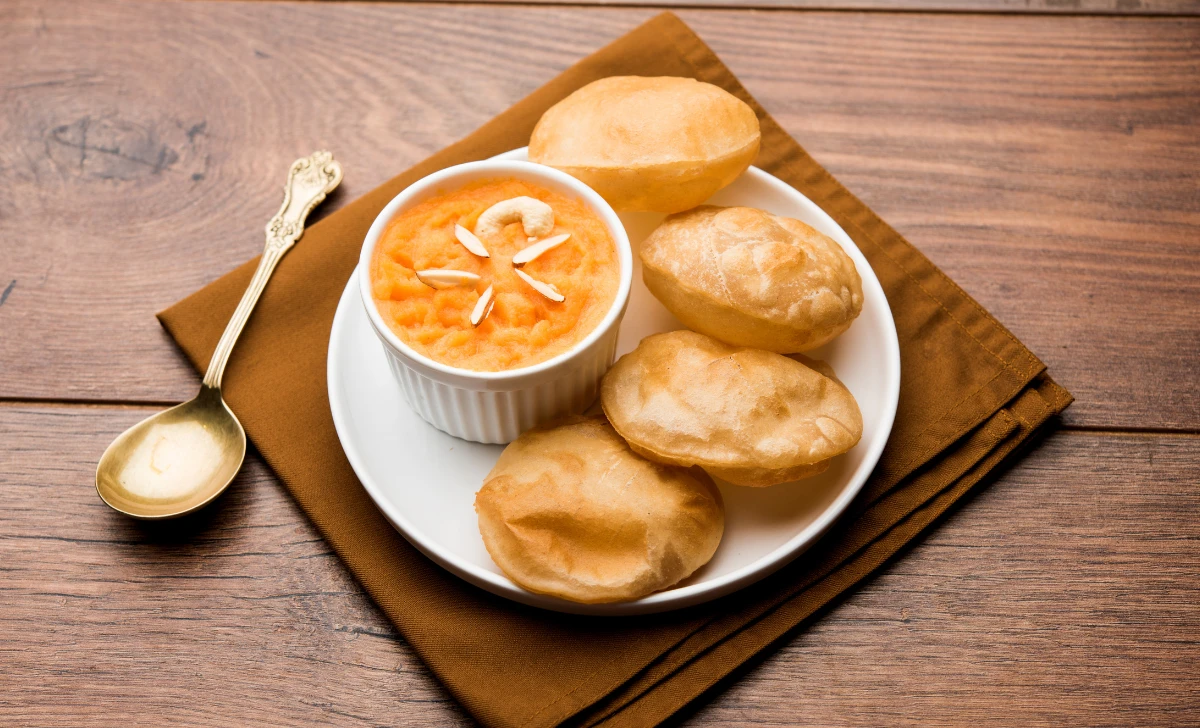

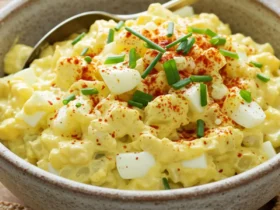
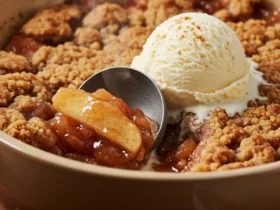
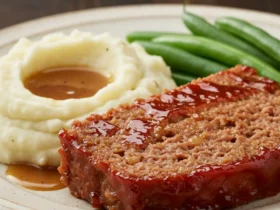
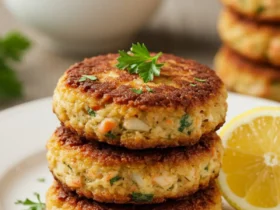
Leave a Review